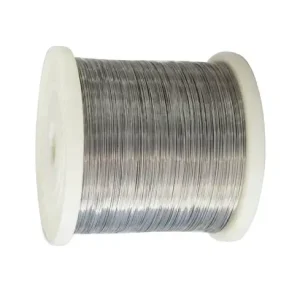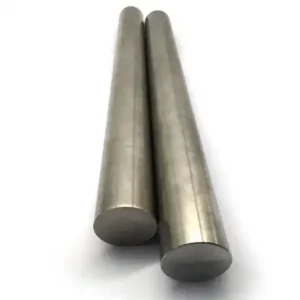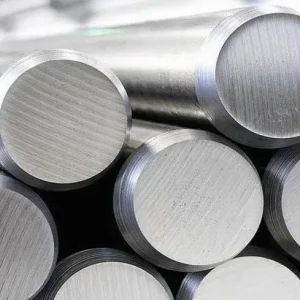Incoloy 825 wire delivers an uncommon blend of corrosion resistance, formability and weldability that makes it a preferred choice for chemical processing, oil and gas, pollution-control and marine service where both oxidizing and reducing environments exist; this wire grade combines high nickel, chromium, molybdenum and copper content with titanium stabilization to resist chloride stress-corrosion cracking and localized attack, while retaining good mechanical strength and reliable fabrication behaviour.
1. What is Incoloy 825?
Incoloy 825 (UNS N08825, W.Nr. 2.4858) is a fully austenitic nickel-iron-chromium alloy that includes controlled additions of molybdenum, copper and titanium. The composition yields balanced corrosion resistance in both oxidizing and reducing media, enhanced resistance to chloride-induced stress-corrosion cracking, and improved behaviour in sulfuric and phosphoric acid environments. Wire products made from this alloy cover a wide range of geometries from fine filament to heavy-diameter rods used for welding, spring elements, resistance heating, chemical plant internals and specialized fasteners.
2. Chemical composition and metallurgical features
Nominal composition ranges (weight percent)
The commonly quoted limiting composition for Incoloy 825 is shown in the table below. These ranges are used by mill producers to control the alloying balance that creates its corrosion performance.
| Element | Typical range (wt%) |
|---|---|
| Nickel (Ni) | 38.0 – 46.0 |
| Iron (Fe) | Balance (remainder) |
| Chromium (Cr) | ~19.0 – 23.0 |
| Molybdenum (Mo) | ~2.0 – 3.0 |
| Copper (Cu) | ~1.0 – 2.5 |
| Titanium (Ti) | ~0.4 – 1.2 (stabilizer) |
| Carbon (C) | ≤ 0.06 |
| Manganese (Mn) | ≤ 1.0 |
| Silicon (Si) | ≤ 0.5 |
(Values above condensed from producer technical bulletins and datasheets.)
Metallurgical rationale
-
Nickel maintains a stable, fully austenitic matrix that reduces susceptibility to intergranular attack and stress-corrosion cracking in chloride-bearing media.
-
Chromium supplies a protective passive film, enhancing resistance to oxidizing media and to localized attack.
-
Molybdenum and copper strengthen corrosion resistance in reducing environments such as sulfuric and phosphoric acid.
-
Titanium acts as a carbide stabilizer, limiting grain boundary precipitation of carbides and thereby helping maintain ductility after fabrication.
3. Physical and mechanical properties (tables)
Below are representative room-temperature properties for mill-annealed Incoloy 825 wire and typical ranges used for design calculations. Individual mill lots will include certified test data that should be used in any final engineering work.
Typical physical constants
| Property | Typical value |
|---|---|
| Density | 8.14 g·cm⁻³ (0.294 lb·in⁻³). |
| Melting range | Approx. 1330 – 1385 °C (variable with composition). |
| Thermal conductivity | Moderate, lower than plain steels |
| Electrical resistivity | Higher than stainless steels, varies with temp |
Representative mechanical properties, mill-annealed (indicative)
| Test | Typical value |
|---|---|
| 0.2% offset yield strength (room T) | 310 – 350 MPa (approx. 45 – 51 ksi). |
| Tensile strength (UTS) | 620 – 770 MPa (approx. 90 – 112 ksi). |
| Elongation (in 50 mm) | 30 – 50% depending on product form. |
| Hardness (Rockwell B) | Typical range 80 – 165 depending on cold work. |
Note: Wire that has been cold-drawn or hardened will exhibit significantly higher tensile and hardness values. For precise numbers consult the mill certificate and product datasheet.
4. Corrosion performance and mechanisms resisted
Broad corrosion behaviour
Incoloy 825 resists general corrosion, pitting and crevice corrosion in many chloride-containing environments; it possesses good resistance to both oxidizing acids such as nitric media and to reducing acids like sulfuric and phosphoric solutions because of the combination of Mo and Cu that hinders local breakdown of the passive film. This alloy also shows reliable resistance to chloride-induced stress-corrosion cracking under many service conditions.
Where it performs particularly well
-
Sulfuric and phosphoric acid systems at moderate temperatures.
-
Aqueous chloride environments where susceptibility to stress-corrosion cracking must be limited.
-
Mixed oxidizing and reducing media, including certain process streams in chemical plants, where many stainless steels will experience rapid degradation.
Known limitations
-
Very aggressive chloride boiling conditions (for example very high temperature, concentrated boiling magnesium chloride) still have potential to attack the alloy; selection must be based on actual process conditions and validated by corrosion testing.
5. Forms, dimensions and common wire product types
Wire products from mills and specialty suppliers appear in these generic categories:
-
Fine wire and filament for resistance winding, sensors and springs.
-
Round wire (cold-drawn) used for fasteners, pins and small fittings.
-
Welding filler wire and rods both bare and flux-cored, used for gas tungsten arc, gas metal arc and shielded metal arc processes. Filler metal classifications include AWS ERNiFeCr-1 and related AWS grades compatible with UNS N08825.
-
Coil wire for winding, coil springs and heating elements.
-
Coated or plated wire where surface finish or additional corrosion protection is required.
Typical size ranges for wire
-
Diameters commonly range from sub 0.1 mm fine wire to several millimetres for drawn rod and welding wire. Heavy wire and rod used for special fasteners may range to 10 mm or more. Product availability depends on the mill and finishing process.
6. Fabrication, welding practice and heat treatment guidance
Cold and hot working
-
The fully austenitic structure provides good ductility and formability for drawing, bending and coiling. Cold drawing increases strength while lowering ductility; appropriate intermediate annealing restores ductility when required.
Welding and filler metal guidance
-
Incoloy 825 is readily weldable by common fusion and resistance methods. Use compatible filler metals when joining to similar or dissimilar alloys. Welding consumables specified to AWS and AMS standards such as ERNiFeCr-1 and certain AMS/ASTM filler specifications are common choices. Preheat is typically not required for thin sections; weld procedures should follow qualified WPS and be validated for the exact assembly.
Heat treatment
-
Typical mill anneal for product release is a solution anneal followed by rapid quench to retain a homogeneous austenitic structure and avoid precipitation of carbides. Heat treatment windows and temperatures will be provided by the supplier for each product form. Post-weld heat treatment is seldom required for corrosion performance, but may be used to relieve heavy residual stresses in fabricated structures.
7. Standards, specifications and quality tests for wire
Common specifications that cover wire and filler
-
ASTM B424 / ASME SB424 — general specification covering nickel alloy bars and wire.
-
ASTM B425 — often cited for wire/rod/filler.
-
AMS 5542 / AMS 5514 — aerospace mill and filler specifications that may apply for some wire forms.
-
AWS classifications for filler metals such as ERNiFeCr-1.
Always confirm which specification the purchaser requires because form factor, heat treatment and testing obligations vary across these standards.
Typical quality control tests at supplier
-
Chemical analysis by spectrometry or wet chemistry to verify alloy limits.
-
Mechanical tests: tensile, elongation and hardness on representative samples.
-
Non-destructive testing where required: eddy current, ultrasonic on larger sections.
-
Surface condition checks and dimensional inspection, traceable mill test certificate supplied with each batch.
8. Typical industries, applications and engineering examples
Incoloy 825 wire finds use in these domains:
-
Chemical process equipment: heating elements, thermocouples supports, tank internals and fasteners used in acidic environments.
-
Oil and gas industry: risers, wellheads, downhole hardware and piping where corrosive brines and H2S may be present; wire used for fasteners and for cladding/filler applications.
-
Pollution control: SCR and FGD systems in flue gas cleaning where mixed oxidizing and reducing conditions appear.
-
Marine and desalination: components exposed to seawater where localized corrosion resistance and stress-corrosion cracking resistance are required.
-
Nuclear and radioactive waste handling: selected process equipment and fixtures due to ability to withstand diverse chemical exposures.
Engineering example: For a heat exchanger internal spring in a phosphoric acid plant, Incoloy 825 wire provides reliable life because copper plus molybdenum limit attack in reducing acid while nickel resists chloride stress-corrosion cracking. Design validation should include corrosion coupon testing under actual process chemistry and temperature.
9. Comparison with related nickel alloys
| Alloy | Where it outperforms Incoloy 825 | Where it underperforms |
|---|---|---|
| Inconel 625 | Higher high-temperature strength; superior pitting resistance in some chloride-rich high temp cases | 825 can be better in some sulfuric/phosphoric acid exposures due to Cu/Mo balance. |
| Alloy 800 | 825 has improved resistance to aqueous corrosion and chloride SCC. | |
| Hastelloy C-276 | C-276 often exceeds 825 for severe reducing environments and more aggressive chloride/pitting situations, but 825 can be more economical. |
Selection must match the precise medium, temperature and mechanical loading; corrosion testing under representative process conditions is strongly recommended.
10. Purchasing, inspection and traceability checklist
When procuring Incoloy 825 wire, require the following minimum documents and controls:
-
Mill Test Report showing chemical analysis and heat number.
-
Specification reference (ASTM/AMS/AWS) required for the order.
-
Mechanical test certificates for tensile and elongation.
-
Dimensional tolerance statement and surface finish requirements.
-
Certification of packaging and handling for cleanliness, anti-contamination and corrosion prevention.
-
Traceability to cast ingot/heat number and manufacturing route.
-
PMI (positive material identification) report on random samples if buyer requires.
11. Handling, storage and safety points
-
Store wire on clean reels or racks, protected against contamination and moisture. Avoid contact with dissimilar metals that could cause galvanic coupling if damp.
-
For welding wire, avoid prolonged exposure to humid air which could lead to surface oxidation and welding porosity.
-
Routine personal protective equipment during handling: gloves, eye protection and standard workshop PPE. Material is not unusually hazardous, but follow MSDS guidance from supplier.
12. Case notes and engineering validation
Before deploying Incoloy 825 wire in a new service environment, the following is recommended:
-
Laboratory corrosion screening under the expected chemistry and temperatures.
-
Weldability trials using the exact wire batch and intended process.
-
Mechanical tests on drawn/hardened wire where cold work is used for final part manufacture.
-
Stress-corrosion cracking assessment where tensile stress and chlorides coincide.
13. Frequently asked questions
-
What is the UNS number for Incoloy 825 wire?
UNS N08825. -
Which standards cover Incoloy 825 wire and filler?
Common references include ASTM B424/B425, ASME SB424, AMS 5542 and AWS filler classifications such as ERNiFeCr-1. Confirm purchaser specification. -
Can Incoloy 825 be welded without special preheat?
For thin sections and typical wire forms no special preheat is usually necessary; however welding procedure qualification and post-weld checks are required for critical service. -
How does Incoloy 825 resist chloride stress-corrosion cracking?
High nickel content stabilizes austenite and reduces susceptibility to SCC, while molybdenum and copper improve resistance to localized breakdown. -
Is Incoloy 825 suitable for seawater service?
It has improved resistance relative to many stainless steels but selection depends on temperature, flow and chloride concentration; testing under intended conditions is advised. -
What product forms of wire are commonly offered?
Fine filament, cold-drawn round, coil wire, welding filler (solid and flux-cored) and plated variants are commonly available. -
Which filler metal classification pairs with Incoloy 825?
AWS ERNiFeCr-1 and AMS/ASTM equivalents are typical for depositing weld metal compatible with the base alloy. -
Does the alloy require special heat treatment after forming?
For most wire uses a mill solution anneal followed by quench is sufficient; further treatment depends on final part requirements. -
Are there economical alternatives to Incoloy 825?
In some less aggressive environments 316L or alloy 800 may be acceptable; for very severe reducing conditions Hastelloy grades are alternatives though cost differs. Validate with corrosion testing. -
How should buyers verify quality on receipt?
Check mill test report, conduct dimensional inspection, random PMI or spectral check, and confirm mechanical test data. For critical orders conduct independent lab verification.
14. Practical procurement note for MWAlloys
If MWAlloys selects Incoloy 825 wire for product lines or sale, include clear specification clauses in sales documents: UNS number, required ASTM/AMS/AWS standards, required mill test certificates, acceptance criteria for surface and dimensional tolerances, and agreed sampling plan for QA tests. For export shipments ensure packaging prevents contamination and includes traceability labels.
15. Summary and final design reminders
Incoloy 825 wire provides a dependable middle ground between standard austenitic stainless steels and high-end nickel superalloys. It is particularly strong when process chemistry includes mixed oxidizing and reducing constituents, chlorides with stress exposure, or sulfuric/phosphoric acid presence. Selection must always rest upon laboratory or field corrosion testing under representative service conditions, and on supplier documentation that proves composition, heat treatment and mechanical properties per the required standard.





